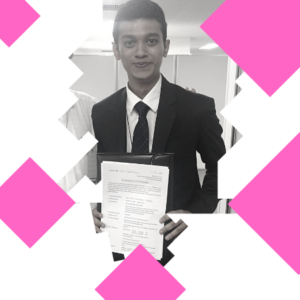
Home » 23755
COMPANY:
manufacturer and supplier of IoT products
A female student majoring in Electronics and Communication Engineering at the University of Pune, India. In the research, she is working on the development of a weather forecast system using machine learning for the purpose of providing weather forecasts with fewer errors than conventional weather forecasts based on physical models. She hopes to work in Japan because she is attracted to Japan's technological prowess and unique culture.
Profile
COUNTRY / REGION
India
SEX
Female
UNIVERSITY
Savitribai Phule Pune University
SPECIALIZATION
Electronics and Telecommunication
ACADEMIC LEVEL
Bachelor
MESSAGE
My journey of learning Japanese started in my second year of engineering. I got to know about the FAST OFFER International program(formerly Study Go Work JAPAN) through one of my friends. She guided me through the process of enrollment. Learning Japanese was a beautiful journey by all my 先生方 where I learned and explored a lot. Along with learning Japanese, there was also the opportunity to work in Japan which just amazed me and motivated me to learn the language, and culture at the same time helped me grow and enhance my personality, and way of thinking. I was really a very shy kind of person but fun learning activities by sensei, cultural exchange sessions with Japanese students, and interacting with fast offer int’l team really boosted my confidence and now I can speak confidently, and interact with people without any nervousness.
When I was studying for the N3 level, I cleared my mock interview and Skype round. One of their team members guided me with the documentation work. Once my profile was ready, I got a match from a company just within 10 days. They took the orientation program for the company, guided me with the answers and ppt slides. Unfortunately, I wasn’t able to clear the first round. After that, for three months I waited for company. They rechecked my profile and asked me to make a few changes. A big thanks to her, right from the next month I started getting company matches. During the second company, there were three rounds, of which I cleared two but was unable to clear the last round.
But If you want something very badly, you get it !! and the same thing happened to me. After the rejection mail, I thought of moving forward and got another company match (Third company). My mentor reviewed my answers and ppt and helped me in improving my ppt slides. Then another team member who took the orientation program for the company guided me through the interview process. In that company also, I wasn’t able to clear the last round. A sudden miracle happened and I received a message from them saying,”The second company where you weren’t able to clear last round has asked for one more interview with you”. I was extremely happy reading those words. The ASIA to JAPAN team really motivated me a lot, I took my interview practices even during my day offs, and due to the huge support and guidance of the FAST OFFER Int’l team, Sensei, my family, and friends, I cleared that last round and finally, it was dream come true moment for me when I received offer letter!!
I am really very grateful for this opportunity and very excited to start my new journey of life in Japan!!
When I was studying for the N3 level, I cleared my mock interview and Skype round. One of their team members guided me with the documentation work. Once my profile was ready, I got a match from a company just within 10 days. They took the orientation program for the company, guided me with the answers and ppt slides. Unfortunately, I wasn’t able to clear the first round. After that, for three months I waited for company. They rechecked my profile and asked me to make a few changes. A big thanks to her, right from the next month I started getting company matches. During the second company, there were three rounds, of which I cleared two but was unable to clear the last round.
But If you want something very badly, you get it !! and the same thing happened to me. After the rejection mail, I thought of moving forward and got another company match (Third company). My mentor reviewed my answers and ppt and helped me in improving my ppt slides. Then another team member who took the orientation program for the company guided me through the interview process. In that company also, I wasn’t able to clear the last round. A sudden miracle happened and I received a message from them saying,”The second company where you weren’t able to clear last round has asked for one more interview with you”. I was extremely happy reading those words. The ASIA to JAPAN team really motivated me a lot, I took my interview practices even during my day offs, and due to the huge support and guidance of the FAST OFFER Int’l team, Sensei, my family, and friends, I cleared that last round and finally, it was dream come true moment for me when I received offer letter!!
I am really very grateful for this opportunity and very excited to start my new journey of life in Japan!!

FINAL YEAR PROJECT
1. 研究の目的
天気予報は人々の生活に影響を与える重要なようそです。全世界が継続的な気候変動とその副作用に苦しんでいるので、正確な天気を予測することは非常に重要です。このプロジェクトの主な目的は、ニューラルネットワークRNN(リカレントニューラルネットワーク)とLSTM(長短期記憶)を使用してモデルを構築し、5日間にわたる地域の平均気温を予測することです。 主な目的は、天気予報の回帰問題を解決するための深いニューラルネットワークを開発することです。 出力は、グラフィカルユーザーインターフェイスを使用して表示されます。
2.過程
最初のステップはデータの収集です。 最低気温、最高気温、平均気温、日の入り、日の出のような5つのパラメーターがあります。このパラメーターの過去のデータセットを使用して、地域の平均気温を予測します。2番目のステップは、データを前処理することです。生データを取得して、マシンラーニングモデルに適したものにします。3番目のステップは、RNN(リカレントニューラルネットワーク)とLSTM(長期短期記憶)を使用してマシンラーニングモデルをトレーニングすることです。データを80:20の比率で分割する必要があります。ここで、80%のデータはモデルのトレーニングに使用され、20%のデータは モデルのテストに使用しています。必要な精度を達成した後、4番目のステップは出力を表示することです。そのためにフロントエンドとバックエンドが接続されています。したがって、グラフィカルユーザーインターフェイスを使用して出力を表します。
3.結果
5日前の地域の平均気温の予測は、グラフィカルユーザーインターフェイスを使用して表示されます。毎日新しいデータ値がデータセットに追加され、システムがより正確な結果を提供するのに役立ちます。
4.振り返り
マシンラーニング技術は、天気を予測するための効果的なアプローチです。 いくつかの制限を与えているいくつかのマシンディープラーニングアルゴリズムがあります。 これらすべてと比較して、精度の点でRNNとLSTMがより正確な結果をもたらすことが実験的に証明されています。 リカレントニューラルネットワークとLSTMは、時系列予測の最もよく知られたアルゴリズムです。 まず、データの前処理があります。 2番目のステップには、LSTMとRNNを使用したデータのトレーニングが含まれます。 3番目のステップは、データのテストです。 この研究では、グラフィカルユーザーインターフェイスを使用して平均気温の出力を表示しています。 出力の精度は90-92%です。 しかし、この研究は平均気温を予測する単一のパラメータに限定されています。 将来的には、平均気温とともに、より多くの気象パラメータを予測できるようになります。
天気予報は人々の生活に影響を与える重要なようそです。全世界が継続的な気候変動とその副作用に苦しんでいるので、正確な天気を予測することは非常に重要です。このプロジェクトの主な目的は、ニューラルネットワークRNN(リカレントニューラルネットワーク)とLSTM(長短期記憶)を使用してモデルを構築し、5日間にわたる地域の平均気温を予測することです。 主な目的は、天気予報の回帰問題を解決するための深いニューラルネットワークを開発することです。 出力は、グラフィカルユーザーインターフェイスを使用して表示されます。
2.過程
最初のステップはデータの収集です。 最低気温、最高気温、平均気温、日の入り、日の出のような5つのパラメーターがあります。このパラメーターの過去のデータセットを使用して、地域の平均気温を予測します。2番目のステップは、データを前処理することです。生データを取得して、マシンラーニングモデルに適したものにします。3番目のステップは、RNN(リカレントニューラルネットワーク)とLSTM(長期短期記憶)を使用してマシンラーニングモデルをトレーニングすることです。データを80:20の比率で分割する必要があります。ここで、80%のデータはモデルのトレーニングに使用され、20%のデータは モデルのテストに使用しています。必要な精度を達成した後、4番目のステップは出力を表示することです。そのためにフロントエンドとバックエンドが接続されています。したがって、グラフィカルユーザーインターフェイスを使用して出力を表します。
3.結果
5日前の地域の平均気温の予測は、グラフィカルユーザーインターフェイスを使用して表示されます。毎日新しいデータ値がデータセットに追加され、システムがより正確な結果を提供するのに役立ちます。
4.振り返り
マシンラーニング技術は、天気を予測するための効果的なアプローチです。 いくつかの制限を与えているいくつかのマシンディープラーニングアルゴリズムがあります。 これらすべてと比較して、精度の点でRNNとLSTMがより正確な結果をもたらすことが実験的に証明されています。 リカレントニューラルネットワークとLSTMは、時系列予測の最もよく知られたアルゴリズムです。 まず、データの前処理があります。 2番目のステップには、LSTMとRNNを使用したデータのトレーニングが含まれます。 3番目のステップは、データのテストです。 この研究では、グラフィカルユーザーインターフェイスを使用して平均気温の出力を表示しています。 出力の精度は90-92%です。 しかし、この研究は平均気温を予測する単一のパラメータに限定されています。 将来的には、平均気温とともに、より多くの気象パラメータを予測できるようになります。




